最新七年级英语上Unit11教学课件
- 格式:ppt
- 大小:486.50 KB
- 文档页数:15
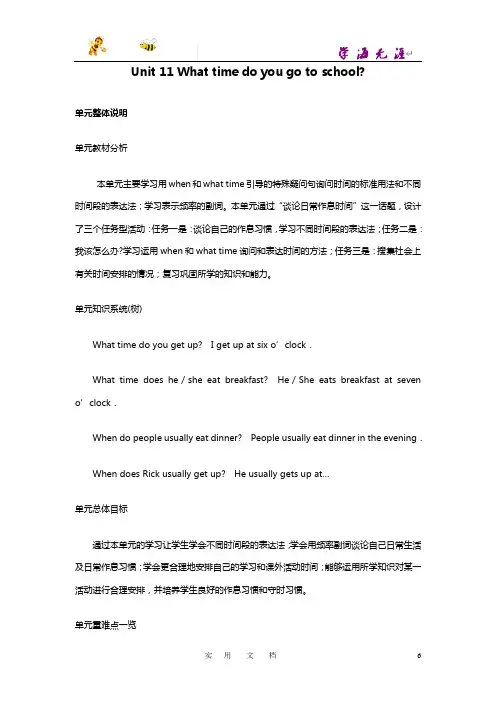
Unit 11 What time do you go to school?单元整体说明单元教材分析本单元主要学习用when和what time引导的特殊疑问句询问时间的标准用法和不同时间段的表达法;学习表示频率的副词。
本单元通过“谈论日常作息时间”这一话题,设计了三个任务型活动:任务一是:谈论自己的作息习惯,学习不同时间段的表达法;任务二是:我该怎么办?学习运用when和what time询问和表达时间的方法;任务三是:搜集社会上有关时间安排的情况;复习巩固所学的知识和能力。
单元知识系统(树)What time do you get up? I get up at six o’clock.What time does he/she eat breakfast? He/She eats breakfast at seven o’clock.When do people usually eat dinner? People usually eat dinner in the evening.When does Rick usually get up? He usuall y gets up at…单元总体目标通过本单元的学习让学生学会不同时间段的表达法;学会用频率副词谈论自己日常生活及日常作息习惯;学会更合理地安排自己的学习和课外活动时间;能够运用所学知识对某一活动进行合理安排,并培养学生良好的作息习惯和守时习惯。
单元重难点一览重点难点1.复习词汇:run,eat breakfast,go to bed,go home2.词汇:go to school,get up,take a shower,always,busy,morning,so,make,schedule,why,because,oldest,longer,afternoon,evening,homework3.句型:What time do you get up? I get up at six o’clock.What time does he /she eat breakfast?He/She eats breakfast at seven o’clock.When do people usually eat diner?People usually eat dinner in the evening.When does Rick usually get up? He usually gets up at…语法重点:when和what tim e引导的特殊疑问句;表示频率的副词。
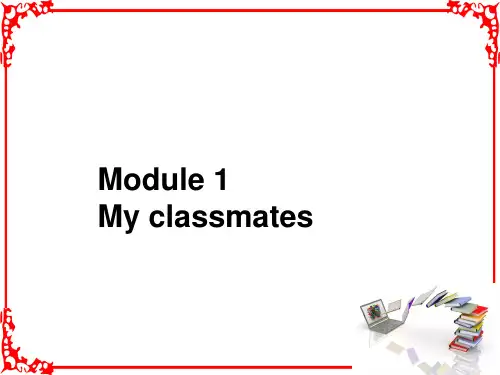


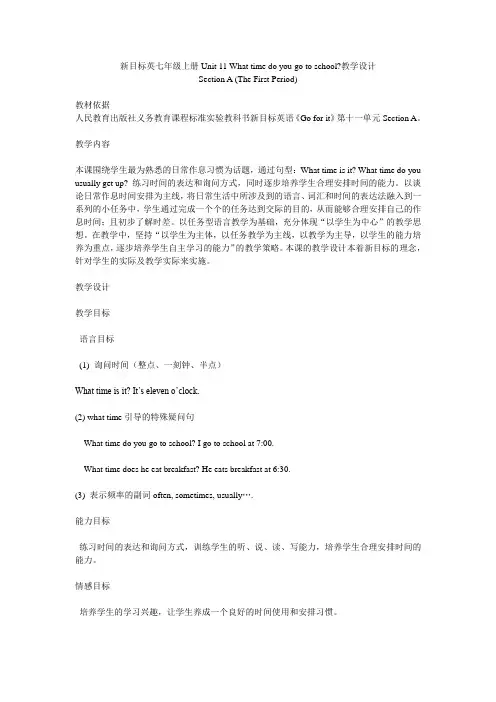
新目标英七年级上册Unit 11 What time do you go to school?教学设计Section A (The First Period)教材依据人民教育出版社义务教育课程标准实验教科书新目标英语《Go for it》第十一单元Section A。
教学内容本课围绕学生最为熟悉的日常作息习惯为话题,通过句型:What time is it? What time do you usually get up? 练习时间的表达和询问方式,同时逐步培养学生合理安排时间的能力。
以谈论日常作息时间安排为主线,将日常生活中所涉及到的语言、词汇和时间的表达法融入到一系列的小任务中,学生通过完成一个个的任务达到交际的目的,从而能够合理安排自己的作息时间;且初步了解时差。
以任务型语言教学为基础,充分体现“以学生为中心”的教学思想。
在教学中,坚持“以学生为主体,以任务教学为主线,以教学为主导,以学生的能力培养为重点,逐步培养学生自主学习的能力”的教学策略。
本课的教学设计本着新目标的理念,针对学生的实际及教学实际来实施。
教学设计教学目标语言目标(1) 询问时间(整点、一刻钟、半点)What time is it? It’s eleven o’clock.(2) what time引导的特殊疑问句What time do you go to school? I go to school at 7:00.What time does he eat breakfast? He eats breakfast at 6:30.(3) 表示频率的副词often, sometimes, usually….能力目标练习时间的表达和询问方式,训练学生的听、说、读、写能力,培养学生合理安排时间的能力。
情感目标培养学生的学习兴趣,让学生养成一个良好的时间使用和安排习惯。
德育目标让学生懂得合理安排时间的重要性和必要性,养成良好的生活习惯。
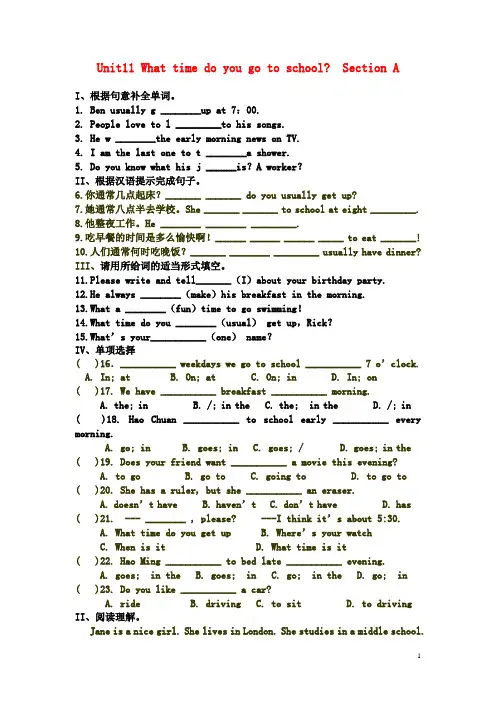
Unit11 What time do you go to school? Section AI、根据句意补全单词。
1. Ben usually g ________up at 7:00.2. People love to l _________to his songs.3. He w ________the early morning news on TV.4. I am the last one to t ________a shower.5. Do you know what his j ______is?A worker?II、根据汉语提示完成句子。
6.你通常几点起床?_______ _______ do you usually get up?7.她通常八点半去学校。
She _______ _______ to school at eight _________.8.他整夜工作。
He ________ ________ _________.9.吃早餐的时间是多么愉快啊!______ ______ ______ _____ to eat _______!10.人们通常何时吃晚饭?_______ ________ _________ usually have dinner? III、请用所给词的适当形式填空。
11.Please write and tell_______(I)about your birthday party.12.He always ________(make)his breakfast in the morning.13.What a ________(fun)time to go swimming!14.What time do you ________(usual) get up,Rick?15.What’s your___________(one) name?IV、单项选择( )16.___________ weekday s we go to school ___________ 7 o’clock.A. In; atB. On; atC. On; inD. In; on( )17. We have ___________ breakfast ___________ morning.A. the; inB. /; in theC. the; in theD. /; in ( )18. Hao Chuan ___________ to school early ___________ every morning.A. go; inB. goes; inC. goes; /D. goes; in the ( )19. Does your friend want ___________ a movie this evening?A. to goB. go toC. going toD. to go to ( )20. She has a ruler, but she ___________ an eraser.A. doesn’t haveB. haven’tC. don’t haveD. has ( )21. --- ________ , please? ---I think it’s ab out 5:30.A. What time do you get upB. Where’s your watchC. When is itD. What time is it( )22. Hao Ming ___________ to bed late ___________ evening.A. goes; in theB. goes; inC. go; in theD. go; in ( )23. Do you like ___________ a car?A. rideB. drivingC. to sitD. to driving II、阅读理解。
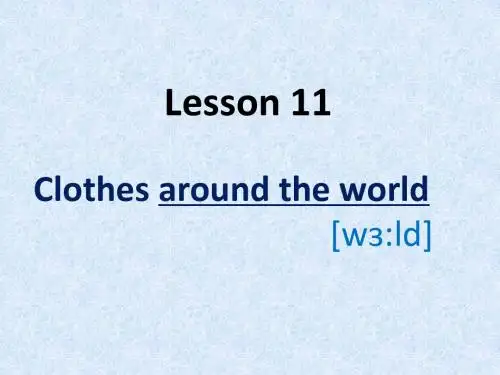
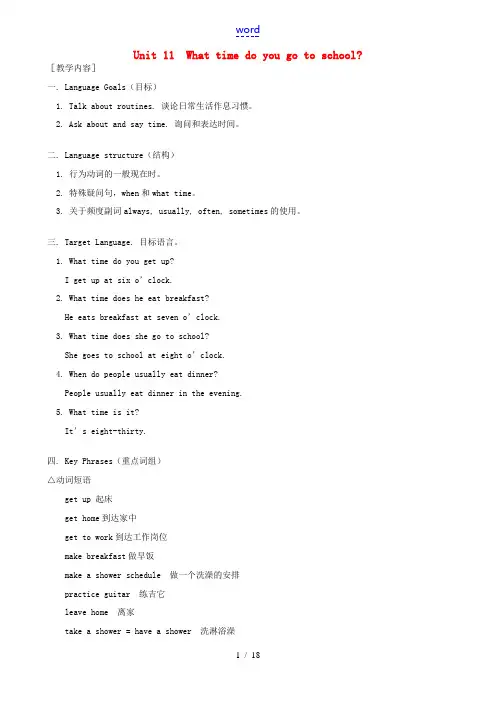
Unit 11 What time do you go to school? [教学内容]一. Language Goals(目标)1. Talk about routines. 谈论日常生活作息习惯。
2. Ask about and say time. 询问和表达时间。
二. Language structure(结构)1. 行为动词的一般现在时。
2. 特殊疑问句,when和what time。
3. 关于频度副词always, usually, often, sometimes的使用。
三. Target Language. 目标语言。
1. What time do you get up?I get up at six o’clock.2. What time does he eat breakfast?He eats breakfast at seven o’clock.3. What time does she go to school?She goes to school at eight o’clock.4. When do people usually eat dinner?People usually eat dinner in the evening.5. What time is it?It’s eight-thirty.四. Key Phrases(重点词组)△动词短语get up 起床get home到达家中get to work到达工作岗位make breakfast做早饭make a shower schedule 做一个洗澡的安排practice guitar 练吉它leave home 离家take a shower = have a shower 洗淋浴澡take the Number 17 bus to the Santon Hotel乘17路公共汽车去Santon 旅馆go to class 上课go to school 上学go to work 上班(反义词 go home)have breakfast/dinner/lunch 吃早、晚、午饭go to bed 睡觉(反义词get up)put on 穿衣服(反义词take off)do one’s homework 做家庭作业tell sb. about sth. 告诉某人某事know about sth. 知道某方面的情况love to do = like to do 喜欢干某事listen to the early morning news on radio听电台早间新闻watch the early morning news on TV看电视早间新闻△其他短语around six o’clock 六点左右in the morning 在早上in the afternoon 在下午in the evening 在晚上listen to 听…五. Key Points (疑难解析)1. What time is it? It’s …这是询问时间的惯用法,如:A: Excuse me. What time is it, please?请问几点了?B: It’s nine o’clock. 九点了。
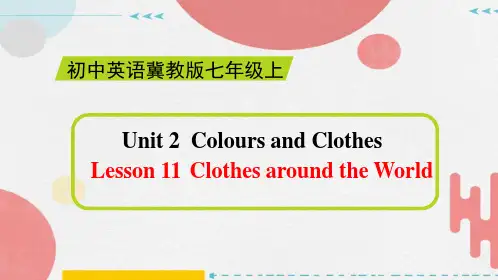
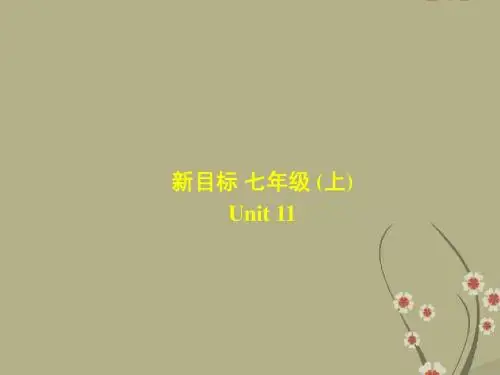
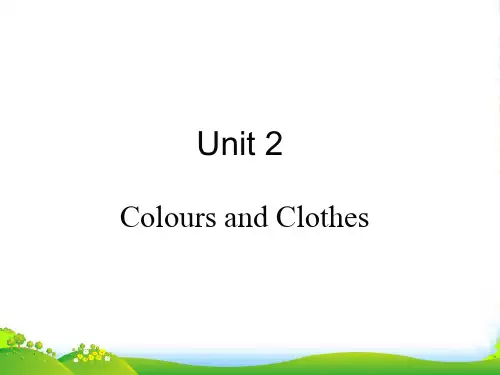
Unit 11重点句型汇总Section A1. —What do you think of soap operas?—I can’t stand them.What do / does + sb. + think of ...? 意为“某人认为……怎么样?”,用来询问对方对某人或某物的观点或看法,相当于How do / does sb. like ...? 但要注意,这两句中的what与how不可混用。
如:What do you think of the magazine? = How do you like the magazine? 你觉得那本杂志怎么样?【特别提醒】How do you like ...? 有“你喜欢……吗?”的意思,常用来询问对方对某事物的喜欢程度。
如:—How do you like Beijing? 你喜欢北京吗?—Very much. 非常喜欢。
2. We’re talking to Alan, a thirteen-year-old boy.thirteen-year-old为合成形容词,其结构为“数词+ 名词+ 形容词”,此结构通常作前置定语。
其中的名词需用单数形式,词与词之间用连字符连接。
如:Maria is an eight-month-old baby. 玛丽亚是一个八个月大的婴儿。
注意:数词+ year(s) old常作表语或后置定语。
如:He is ten years old. 他十岁。
Section B1. I showed each student six things and asked them about each one.show作及物动词时,意为“给……看”,常构成show sb. sth.或show sth. to sb.结构。
如:She showed us some interesting pictures. = She showed some interesting pictures to us. 她给我们看了一些有趣的照片。
Unit 1 My name’s Gina.第一课时Section A :1a-2c1、教学目标:本课时以name为中心话题,1b,2a,2b都是与name句型有关的听力,1c,2c是围绕name展开的小组活动,2d是围绕name内容的展开的情景交际2、重点单词:name , nice, to, meet, too, your, Ms., his, and, her, yes, she, he, no, not,3、重点词组:Nice to meet you4、重点句型:What’s you r/his/her name?5、能力目标:Enable students to greet peopleHelp students learn how to introduce themselves.6、情感目标:培养学生在英语学习中与人合作的精神。
教学步骤:I. Warm-up and revision1. Play the tape, enjoy the ABC song or Hello song, get the Ss to sing together.2. Divide the class into Group A and B. Draw two fishes on the blackboard as their symbols, tell the students that each time they answer questions right, they can get one or more points for their group and draw one or more bubbles around their fish, at the end of the class, the group which gets more bubbles will be the winner today. Say, “One, two, three!” Get the whole class sit straight, thus announce the beginning of the competition.3. Revise the three units in Starters. Show some key sentences in Chinese on the screen, have students translate them into English, get a student from each group to come to the front and write down their answers on the blackboard, then check the answers, each correct sentence will earn a point for the group. II. PresentationTeacher says: , “Hello! My name is Lily. What’s your name?” Get the students to answer, “My name is …”Then teacher says, “It’s a good / nice name. I like your name.”On the screen show a lovely mouse saying “My name’s Gina.” Underline “My name’s”, tell the students it means “My name is/ I am/ I’m”.Show the question “What’s your name?” Underline “What’s”, tell the students that it means “What is”. III. Listening drillsDo Section A, 1b, listen and number the conversations (1-3).Show the picture on page 1 on the screen with no words on it. Get student to listen to the tape and try to repeat the sentences in the conversations, each correct sentence will earn a point for the group.IV. Pair-work.Get the students listen to the conversations again and repeat after the tape, then work in groups, practice the conversations with the partners.Have some students come to the front and show their own conversation, then make a comment on it (praise the students first) and give 2 to 4 points to their group.Do Section A, 1a. First, have the students work in groups, write down as many words as possible on their students’ books in only 2 minutes; then get a student from each group to write down their words on the blackboard at the same time, the one who writes more can get more points.V. Listening drillsDo Section A, 2a. Listen to four conversations and number the pictures (1-4).Do Section A, 2b. Listen again, circle the names according to the tape.Listen for the last time, then fill in the blanks.Ⅵ.Homework:Listen and read after the tape for thirty minutes.Recite the first conversation of Section A, 2c.Write down the Chinese meaning of the new words and key sentences, then translate them into English.。